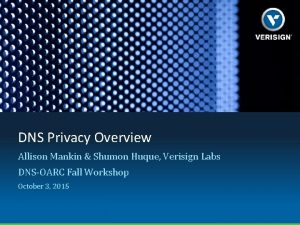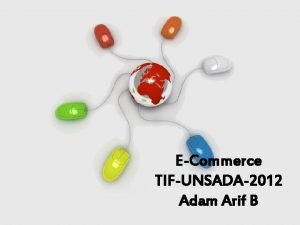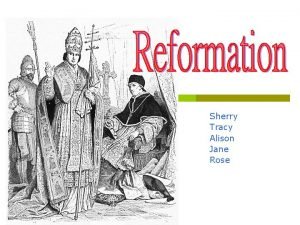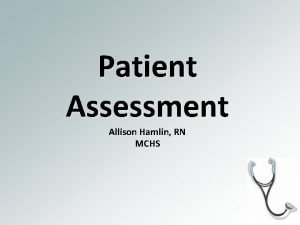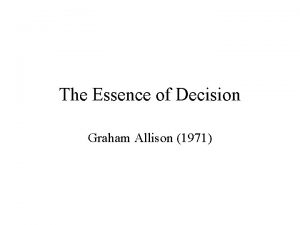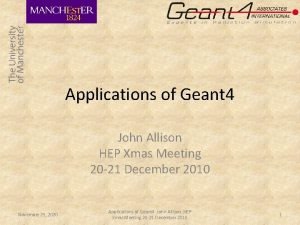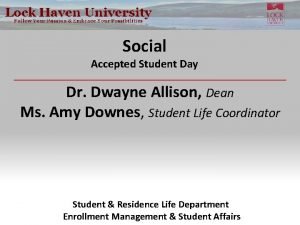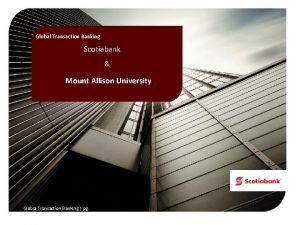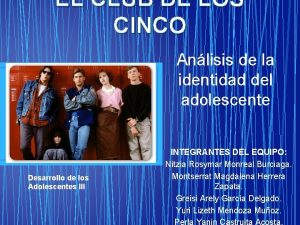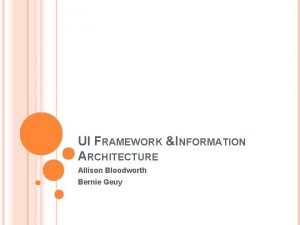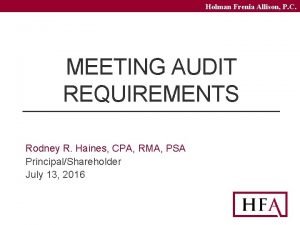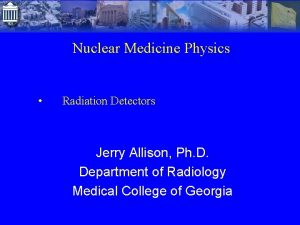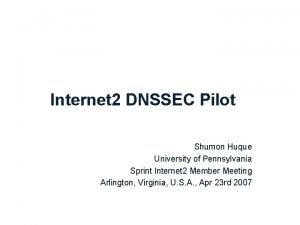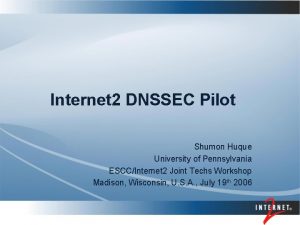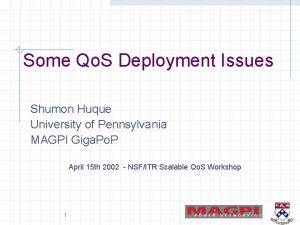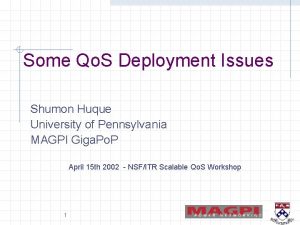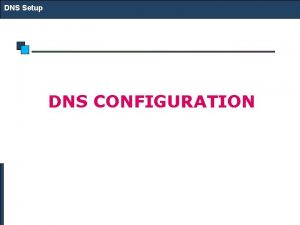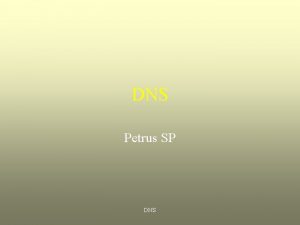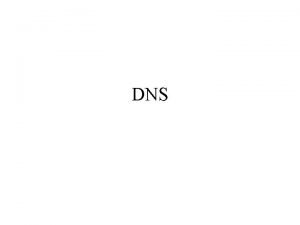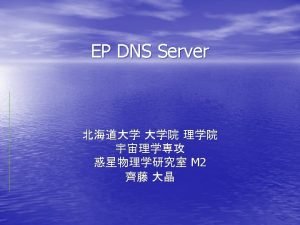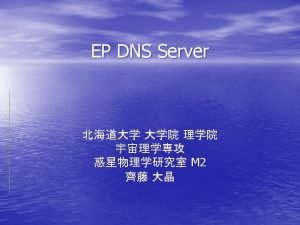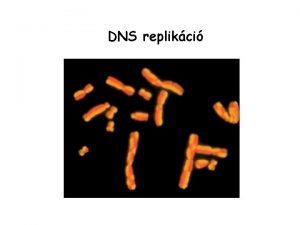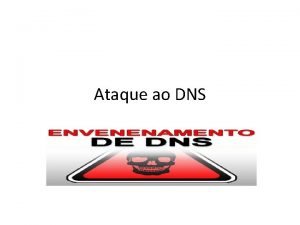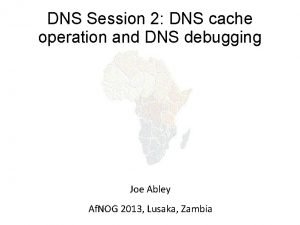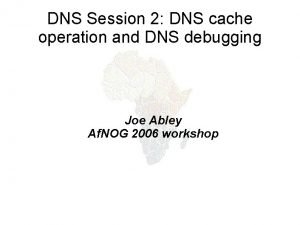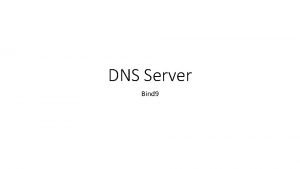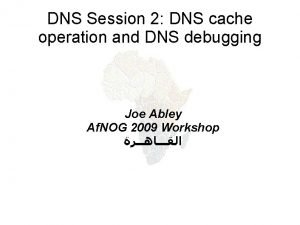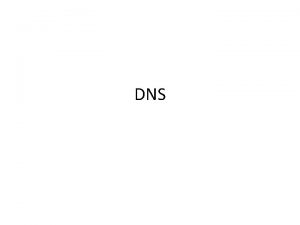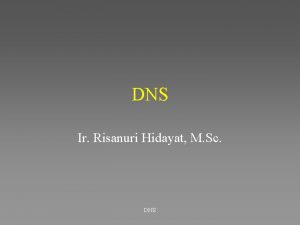DNS Privacy Overview Allison Mankin Shumon Huque Verisign







































- Slides: 39

DNS Privacy Overview Allison Mankin & Shumon Huque, Verisign Labs DNS-OARC Fall Workshop October 3, 2015

Background • • DNSSEC (RFC 4033) specifically has no confidentiality requirement DNSSEC did consider a privacy requirement (avoidance of zone enumeration) in adding NSEC 3 to the extensions • • Consistent with guidance and protocols for confidentiality for zone transfers Outside IETF, services such as dnscurve and dnscrypt offered confidentiality • Did not get on standards radar • This changed with PERPASS effort and its output, RFC 7258 • IETF formed DNS Private Exchange (DPRIVE) WG in 2014 • DPRIVE has just issued its first RFC, DNS Privacy Considerations (RFC 7626) Verisign Public 2

RFC 7258 - Pervasive Monitoring is an Attack • Essential message conveyed by its abstract (entirety): • • • Pervasive monitoring is a technical attack that should be mitigated in the design of IETF protocols, where possible. Focus on meta-data in addition to data plane • Some attention to this previously, such as IPv 6 privacy addresses • Renewal of focus and effort Consider broad range of risks • Protocol design issues • Interactions/intersections between protocols • Verisign Public Side channels – for example, size- and timing-based information leakage 3

RFC 7624 – Confidentiality Threat Model • Follows on from RFC 7258 • More detail and terminology • • • More linkage to the Privacy Considerations Best Current Practices (BCP) (RFC 6973) Background and bibliography on in-the-wild Pervasive Monitoring Places DNS privacy in broad context (3. 1, 3. 2, 3. 3. 2, 5. 2) Verisign Public 4

RFC 7626 – DNS Privacy Considerations • • Expert coverage of risks throughout DNS ecosystem Linkage to RFC 6973 (Privacy Considerations for Internet Protocols) • Rebuts “alleged public nature of DNS data” • Covers: • Targets in the DNS data • Places in the DNS ecosystem where data may be tapped • • Verisign Public Places in the DNS ecosystem where data is collected, that may be misused or compromised Indirect sources of privacy disclosure such as cache snooping (timing probes) 5

Privacy Evaluation • An individual draft • Presentations in DPRIVE at IETF-91, IETF-92, and IETF-93 • Attempt to connect IETF efforts with privacy formalisms • • Supports quantitative evaluation of privacy methods (on their own or combined) draft-am-dprive-eval-01. txt Verisign Public 6

Overview of DNS Privacy Risks Verisign Public 7

DNS Privacy Risks • DNS data may be at risk of disclosure: • Between client and recursive • At recursive name server • Between recursive and authoritative • At authoritative name server • Data may also be at risk of modification: privacy risk if client misdirected • Important to consider such risks as part of overall privacy strategy • Presentation will be light on modification/DNSSEC angle Verisign Public

Risk 1: Between Client and Recursive • Client effectively reveals browsing history via DNS traffic to recursive name server • Adversary must be “on path” to see it, but it’s all in one place • Risk increases when recursive name server deployed outside organization • How to protect against eavesdropping? Verisign Public

Risk 1: Between Client and Recursive www. example. com Web Server 93. 184. 216. 34 Root Name Server Q: www. example. com? 3 A: ask. com name server 2 Recursive Name Server . com Name Server Q: www. example. com? 9 10 HTTP Response Q: www. example. com? 4 Eavesdrop 5 1 8 A: ask example. com name server A: 93. 184. 216. 34 6 example. com Name Server Q: www. example. com? 7 A: 93. 184. 216. 34 Verisign Public HTTP Request Internet User (Client)

Risk 2: at Recursive Name Server • Recursive name server learns client’s browsing (and other) history through its DNS traffic • Adversary may compromise server systems to get this data • Server itself may be “adversary, ” misusing data … • How to protect against compromise, misuse? Verisign Public

Risk 2: at Recursive Name Server www. example. com Web Server 93. 184. 216. 34 Root Name Server Q: www. example. com? 3 A: ask. com name server 2 Recursive Name Server . com Name Server Q: www. example. com? 9 10 HTTP Response Q: www. example. com? 4 1 Misuse 5 A: ask example. com name server 8 A: 93. 184. 216. 34 6 example. com Name Server Q: www. example. com? 7 A: 93. 184. 216. 34 Verisign Public HTTP Request Internet User (Client)

Risk 3: Between Recursive and Authoritative • Recursive name server reveals samples of community’s lookup history via DNS traffic to authoritative name servers • Adversary again must be “on path” to see traffic, but all in one place • Authoritative name servers by definition deployed outside organization • How to protect against eavesdropping? Verisign Public

Risk 3: Between Recursive and Authoritative Root Name Server www. example. com Web Server 93. 184. 216. 34 Q: www. example. com? 3 op sdr ve A: ask. com Ea name server 2 Recursive Name Server . com Name Server Q: www. example. com? Ea 5 op sdr e v 10 HTTP Response 1 8 A: 93. 184. 216. 34 6 example. com Name Server Q: www. example. com? op Ea sdr ve A: 93. 184. 216. 34 Verisign Public 9 Q: www. example. com? 4 A: ask example. com name server 7 HTTP Request Internet User (Client)

Risk 4: at Authoritative Name Server • Authoritative name server learns samples of recursive’s community’s browsing history • Adversary may again try to compromise server systems to get this data • Server itself may again be “adversary” • How to protect against compromise, misuse? • A hybrid risk: authoritative server learns recursive client’s identity via the use of edns-client-subnet option by the intervening recursive server. This is done normally for service optimization purposes, but nonetheless represents a privacy leakage. Verisign Public

Risk 4: At Authoritative Name Server www. example. com Web Server 93. 184. 216. 34 Root Name Server Q: www. example. com? Misuse 3 A: ask. com name server 2 Recursive Name Server . com Name Server Q: www. example. com? Misuse 9 10 HTTP Response Q: www. example. com? 4 1 5 A: ask example. com name server 8 A: 93. 184. 216. 34 6 example. com Name Server Q: www. example. com? Misuse 7 A: 93. 184. 216. 34 Verisign Public HTTP Request Internet User (Client)

Summary of DNS system risks Root Name Server 93. 184. 216. 34 Q: www. example. com? p Misuse ro esd av 3 A: E ask. com name server 2 Recursive Name Server . com Name Server Q: www. example. com? op Misuse Ea 5 sdr ve Q: www. example. com? op r esd v a 4 A: ask example. com name server Misuse Q: www. example. com? rop 7 esd v a E A: 12. 345. 678. 90 Verisign Public 8 A: 12. 345. 678. 90 6 example. com Name Server Misuse 1 E Internet User (Client)

Overview of Mitigations Verisign Public 18

Mitigating DNS Privacy Risks • Data handling policies can help mitigate the risks • Technical enhancements to DNS have also been introduced & proposed in recent years to mitigate these risks: • • DNS-over-TLS • qname-minimization • DANE and DNSSEC* (*DNSSEC might help in the sense that unauthorized modification of DNS traffic can present a privacy risk if a client is misdirected to a resource in the control of an adversary. ) Verisign Public

Mitigation 1: DATA HANDLING • Data handling policies, technologies and audits can mitigate risk of compromise, misuse of data at recursive, authoritative servers • Root, top-level domain servers generally operate under established agreements • Other authoritative name servers, recursive name servers may not Verisign Public

Risks 2 & 4: Misuse www. example. com Web Server 93. 184. 216. 34 Root Name Server Q: www. example. com? Misuse 3 A: ask. com name server 2 Recursive Name Server . com Name Server Q: www. example. com? Misuse 9 10 HTTP Response Q: www. example. com? 4 1 Misuse 5 A: ask example. com name server 8 A: 93. 184. 216. 34 6 example. com Name Server Q: www. example. com? Misuse 7 A: 93. 184. 216. 34 Verisign Public HTTP Request Internet User (Client)

Mitigation 1: Data handling www. example. com Web Server 93. 184. 216. 34 Root Name Server Protect Q: www. example. com? 3 A: ask. com name server 2 Recursive Name Server . com Name Server Q: www. example. com? Protect A: ask example. com name server Q: www. example. com? 7 A: 93. 184. 216. 34 Verisign Public 10 HTTP Response 1 8 A: 93. 184. 216. 34 6 example. com Name Server Protect 9 Q: www. example. com? 4 Protect 5 HTTP Request Internet User (Client)

Mitigation 2: Encryption (DNS-over-TLS etc. ) • Like other Internet protocols, DNS can be made more secure and information disclosure can be reduced by running over Transport Layer Security (TLS) • IETF DPRIVE working group currently developing DNSover-TLS specification and others • Mitigates eavesdropping (risks 1 & 3) • Verisign Public Also mitigates modification in transit

Mitigation 2: Encryption (DNS-over-TLS) • DNS Over TLS: Initiation and Performance Considerations • https: //tools. ietf. org/html/draft-ietf-dprive-dns-over-tls • New well known port (TBD) for DNS over TLS • TLS: follow best practices of RFC 7525 • Two profiles defined: an opportunistic profile (no server authentication), and a pre-configured profile. • Details of performance considerations and recommendations: • • Verisign Public Connection reuse, pipelining, out-of-order response processing, use of TCP Fast Open if available, use of TLS session resumption, and other optimizations. Implementations already emerging (see next talk!)

Risks 1 & 3: Eavesdropping www. example. com Web Server 93. 184. 216. 34 Root Name Server Q: www. example. com? 3 op sdr ve A: ask. com Ea name server 2 Recursive Name Server . com Name Server Q: www. example. com? Ea 5 o sdr e v p 10 HTTP Response Eavesdrop 1 8 A: 93. 184. 216. 34 6 example. com Name Server Q: www. example. com? op Ea sdr ve A: 93. 184. 216. 34 Verisign Public 9 Q: www. example. com? 4 A: ask example. com name server 7 HTTP Request Internet User (Client)

Mitigation 2: Encryption (DNS-over-TLS etc. ) www. example. com Web Server 93. 184. 216. 34 Root Name Server Q: www. example. com? Encrypt 3 A: ask. com name server 2 Recursive Name Server . com Name Server Q: www. example. com? Encrypt 5 9 10 HTTP Response Q: www. example. com? 4 1 Encrypt A: ask example. com name server 8 A: 93. 184. 216. 34 6 example. com Name Server Q: www. example. com? Encrypt 7 A: 93. 184. 216. 34 Verisign Public HTTP Request Internet User (Client)

Mitigation 3: Qname Minimization • DNS information disclosure can be reduced by asking authoritative only enough for referral to next server – not full query name (“qname”) each time • IETF DNSOP working group currently developing qname minimization spec • • • Completed DNSOP WGLC and soon will go to IETF Last Call Partially mitigates eavesdropping (risk 3) w/o encryption or changing authoritative For a more detailed treatment, see “Query-name Minimization and Authoritative Server Behavior – S. Huque”, Spring 2015 DNS-OARC workshop: https: //indico. dns-oarc. net/event/21/contribution/9 Verisign Public

Risk 1 & 3: Eavesdropping www. example. com Web Server 93. 184. 216. 34 Root Name Server Q: www. example. com? 3 op sdr ve A: ask. com Ea name server 2 Recursive Name Server . com Name Server Q: www. example. com? Ea 5 op sdr e v 9 10 HTTP Response Q: www. example. com? 4 1 8 A: ask example. com name server A: 93. 184. 216. 34 6 example. com Name Server Q: www. example. com? 7 A: 93. 184. 216. 34 Verisign Public HTTP Request Internet User (Client)

Mitigation 3: Qname Minimization www. example. com Web Server 93. 184. 216. 34 Root Name Server Q: www. example. com? Minimize 3 A: ask. com name server 2 Recursive Name Server . com Name Server Q: www. example. com? 10 HTTP Response 1 Minimize A: ask example. com name server 8 A: 93. 184. 216. 34 6 example. com Name Server Q: www. example. com? 7 A: 93. 184. 216. 34 Verisign Public 9 Q: www. example. com? 4 5 HTTP Request Internet User (Client)

Summary: Risk Mitigation Matrix DNS System Level Risks Mitigations Client to Recursive Data Handling (Policies) Encryption (DNS-over. TLS etc. ) qname minimization Verisign Public At Recursive to Authoritative Mitigate Misuse Mitigate Monitoring At Authoritative Mitigate Misuse Mitigate Monitoring 30

Some Additional Risks and Mitigations Verisign Public 31

Zone Enumeration • Consider zones with policy limiting access to data as a whole • • DNSSEC proof of non-existence, NSEC, re-opens this risk • • • Access control for AXFR and IXFR, and channel encryption Enclosing proof has plaintext names, and adversary can zone-walk through random queries (RFC 4033 -4035) NSEC 3 (RFC 5155) mitigates zone-walking through hashing, but now can be compromised by well-resourced adversary Research proposal, NSEC 5 (i-d ref) mitigates this attack • • Ongoing discussion in DNSOP WG – tradeoffs of risk versus cost (due to online signing) Tradeoff may be in favor for DANE zones where enumeration would produce catalog of public keys Verisign Public 32

Side Channels • • • Even when a data flow is encrypted, private information may be inferred by various means Side-channel attacks – well known ones include: • Size-based • Timing-based Cache snooping is an example of a timing-based attack • • • In some cases, in-cache responses (faster than not in-cache ones) can reveal what names are queried by the target individual Adversary needs to identify recursive used by target and gain access Another form of cache snooping: targeted RD=0 queries: • • Verisign Public DNS Cache Snooping, Feb 2004 (L Grangeia) http: //cs. unc. edu/~fabian/course_papers/cache_snooping. pdf 33

Size-based Side Channels • • • Size-based attacks have been practiced on TLS, Skype and other encrypted traffic DNS once encrypted still has some predictable query/response patterns Another advantage for practicality of this attack is that adversary may have access to known plaintext (by making its own queries) • • Shulman IRTF ANRP award paper at IETF-93 stimulated discussions in DPRIVE and TLS WGs Known mitigation is to pad requests & responses so that they have uniform length Verisign Public 34

Size-based Side Channels (cont. ) • DPRIVE: draft for an EDNS(0) padding option: • • https: //tools. ietf. org/html/draft-mayrhofer-edns 0 -padding TLS: multiple choices • • • Verisign Public Existing padding options, but they have been impacted in TLS by some attacks (Poodle, …) Create new application padding option that TLS stacks could use for DNS (in our case) Wait a bit longer for TLS 1. 3, which has been addressing a requirement for cryptographically analyzed padding and is a green field 35

Leakage of DNS Names by Other Protocols • • • Impact of developing privacy enhancements for DNS Before, with no DNS privacy, pressure was low to avoid DNS name disclosures in plaintext in other protocols That may be changing: • • TLS use of cleartext domain names in handshake, now recognized as a risk DHCP – an Anonymity Profile document that is currently in WGLC provides options that allow an end-system not to expose its FQDN (this was a PERPASS outcome) • Verisign Public https: //tools. ietf. org/html/draft-ietf-dhc-anonymity-profile 36

DNS name leakage in TLS • Server Name Indication extension (SNI) exposes the domain name of the intended server • • • An issue where many named services are hosted on common platforms like large CDNs. Tricks to obfuscate the server name have already emerged. See “domain fronting” www. icir. org/vern/papers/meek-PETS-2015. pdf DNS names also exposed in TLS Certificate messages. TLS 1. 3 protocol designers are discussing ways to encrypt and prevent these exposures. (Note: SNI encryption is at best a partial solution to hiding a service name. A more complete solution involves mechanisms well beyond just the DNS, such moving servers into anonymity networks. See Facebook’s Tor hidden servicefor example at “facebookcorewwwi. onion”. ) Verisign Public 37

Summing Up • • Background and Risk Overview RFCs 7258, 7624, 7626 • Enumeration • Privacy evaluation • User Identifier LHS • Side-channels DNS Privacy Risks – System View • Between client and recursive • Size-based side channel • At recursive • Research (no slide) • Between recursive and authoritative At authoritative Mitigations – System View Verisign Public Additional Risks and Mitigations • • • Transitivity networks • DNS Ecosystem variants • Unlucky Few Domain Name Leakage in Other Protocols • Data Handling (Policies) • Query Confidentiality • TLS server name extension • Qname Minimization • DHCP FQDN option • More work to be done! 38

Questions/Comments? Verisign Public 39
 Allison mankin
Allison mankin Bisnis otentikasi verisign
Bisnis otentikasi verisign Cvs privacy awareness and hipaa privacy training
Cvs privacy awareness and hipaa privacy training Tracy allison mediation
Tracy allison mediation Allison maclaurin
Allison maclaurin Allison fansler
Allison fansler Chuck allison
Chuck allison Allison beth quillin
Allison beth quillin Sogolon kedjou's animal sign is
Sogolon kedjou's animal sign is Oral surgeon hamlin
Oral surgeon hamlin Allison 1971
Allison 1971 Allison gauss
Allison gauss Dwayne allison
Dwayne allison Allison
Allison Jerry allison
Jerry allison Mount allison university bookstore
Mount allison university bookstore Allison vaillancourt
Allison vaillancourt Allison mumbleau
Allison mumbleau Allison lorenz
Allison lorenz Andrew clark el club de los cinco
Andrew clark el club de los cinco Jerry allison
Jerry allison Kirsten norris
Kirsten norris Dr lee allison
Dr lee allison Allison zmuda
Allison zmuda Allison barfield
Allison barfield Kohl's organizational chart
Kohl's organizational chart Garry allison
Garry allison Allison bloodworth
Allison bloodworth Avatrombopag
Avatrombopag Holman frenia allison
Holman frenia allison Dr allison clarke
Dr allison clarke What is the montessori philosophy
What is the montessori philosophy Allison lackie
Allison lackie Chuck allison
Chuck allison Jerry allison
Jerry allison Alisson tayler
Alisson tayler Jerry allison
Jerry allison Allison sweeney bio
Allison sweeney bio Allison keegan
Allison keegan Nsongonya
Nsongonya
